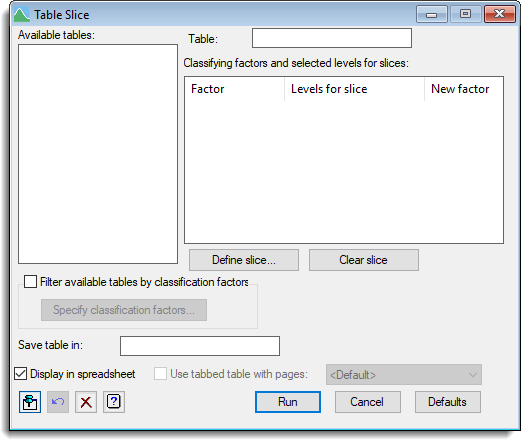Select menu: Data | Table Slice
Use this to extract sub-tables from existing tables. You can specify levels from each classifying factor, and all other levels of the factor will be dropped from the table. If you select just a single level then that slice of the table will be retained and that factor will be dropped from the list of classifying factors of the resulting table. When a subset of levels for a classifying factor is defined, a new factor for the classifying factor of the resulting table has to be defined.
- After you have imported your data, and created a table, from the menu select
Data | Table Slice.

Available tables
Lists table data structures. Double-click a name to copy it into the table or save table in fields (depending which one last had focus). If you move the cursor over a name in the list a tool-tip displays showing the classifying factors. This list can be reduced to only display those tables with specific classifying factors by selecting the Filter available tables by classification factors check box and choosing the factors.
Filter available tables by classification factors
When selected, the factors listed in the Select classifying factors for table list menu will be used to filter the tables shown in the Available tables list.
Specify classification factors
This opens a menu that lets you select classifying factors for the table list. Only tables with classifying factors matching the selected list will then be displayed in the Available tables list.
Table
Specifies the name of a table structure to be sliced. You can type the name of the table or double-click a table in the Available tables list.
Classifying factors and selected levels for slices
This provides a list of the classifying factors from the table in the Table field. You can change the levels to be retained for a classifying factor in the slice by double-clicking the factor’s name, or by clicking Define slice. This opens a menu where you can select levels for a slice.
Define slice
For the currently selected factor in the Classifying factors and selected levels list this opens a dialog allowing you to select the levels of a classifying factor that will be retained for the slice.
Clear slice
For the currently selected factor in the Classifying factors and selected levels list this removes the levels that have been defined and resets the selection to all levels.
Recalculate table margins
This option willl only appear if your table has margins. When selected the margins in the slice will be calculated using the summary statistic selected in the dropdown list. Otherwise, no margins will be calculated for the new table. Note that the margins are only evaluated for the levels in the new table. The margin summary options are:
| Total | Creates the margins using the total of the values in the table. |
| Mean | Creates the margins using the mean of the values in the table. |
| Minima | Creates the margins using the minimum of the values in the table. |
| Maximum | Creates the margins using the maximum of the values in the table. |
| Median | Creates the margins using the median of the values in the table. |
| Variance | Creates the margins using the variance of the values in the table. |
Save table in
Specifies a table structure to contain the new sliced table.
Display in spreadsheet
Lets you display the sliced table in a new spreadsheet.
Use tabbed table with pages
When selected, the spreadsheet will be formed using a tabbed-table and the factor across the pages/tabs will be the classifying factors selected from the dropdown list of classifying factors in the table. The default page factor is the first classifying factor in the table. A table must have at least 3 classifying factors to be displayed in a tabbed-table.
Action Icons
| Pin | Controls whether to keep the dialog open when you click Run. When the pin is down |
|
| Restore | Restore names into edit fields and default settings. | |
| Clear | Clear all fields and list boxes. | |
| Help | Open the Help topic for this dialog. |
Example
Examples of creating and manipulating tables can be found in table examples.